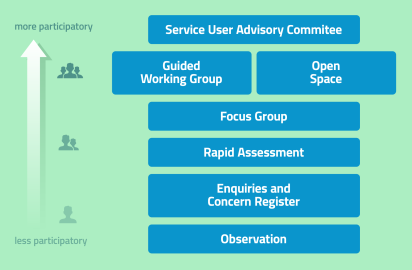Participatory Needs Assessment
Where information required to assess the needs of the target group is missing, additional data can be collected using participatory methods: by involving project personnel and the target group (and other stakeholders where relevant) in the planning and implementation of data collection and in the analysis. Several levels of participation are possible.
Advantages and Disadvantages of Participatory Needs Assessment
- Lived experience is taken into account more and the needs of the target group are assessed more appropriately when their knowledge, their perspectives and their approaches to interpretation are included.
- Using participation at the Needs Assessment stage offers a springboard for the development of health promotion and prevention strategies that orient themselves on lived experience.
- Involving practitioners in the needs assessment utilises their local, specialist and practical knowledge. It enhances their (research) capacity and improves the chances that the results of a Needs Assessment will actually be used.
- Including target group members strengthens their status and capacity to act – they are mobilised for their own cause (empowerment).
- When practitioners and target group representatives jointly assess the needs of the target group, it promotes collaboration and increases the credibility of the results.
- When the target group participates, data collection instruments (e.g. questionnaires) as well as the results of the needs assessment can be articulated in the language of the people to be reached.
- On the other hand, participation is relatively time and labour intensive.
- The results of Participatory Needs Assessments are often highly relevant to the local context, and therefore offer only limited generalisability further afield.
The Process of Participatory Needs Assessment
It should be clarified initially whose needs are to be assessed, i.e. the target group must be defined. Secondly, service organisations and individuals who possess knowledge required for the needs assessment (lived experience or specialist knowledge) should be involved. Relevant information from a variety of sources is reviewed (see also possible information sources for Needs Assessments). When it is clear which information is missing, research questions can be developed for data collection. A variety of methods can be used to collect the data.
Methods of Participatory Needs Assessment
In principle, the repertoire of participatory methods to collect data for assessing the needs of a target group is unlimited. The methods suggested here have been field tested in a variety of contexts and can be implemented relatively easily, even when resources are limited. The degree of participation (in terms of power to define one’s own health problems and decision-making power) differs depending on the method.
Fig.1: Degrees of Participation in Comparison

Authors:
Unger/Block/Wright
